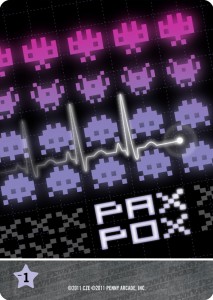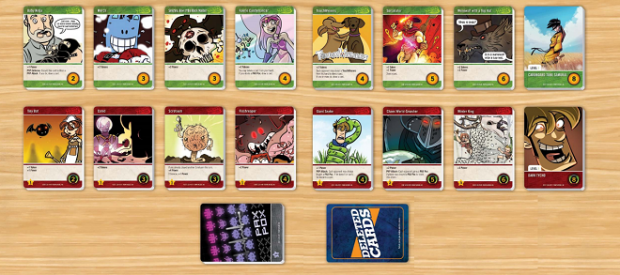Friday Night Unplugged #21: Penny Arcade The Game: Gamers vs Evil
- Updated: 17th May, 2013
We’ve had a two-week break and of course it’s a Friday so we’ve got something light to show you this week. Unfortunately we don’t have the extra Magic: The Gathering piece we promised for you this week because well, we just haven’t played enough to get a good feel for the new set. We will have it up soon though, so have no fear. In this Unplugged column we’re watching geek culture eat itself by playing the Penny Arcade deckbuilding game Gamers vs Evil.
What is it:
Penny Arcade: Gamers vs Evil is a card game from Cryptozoic Entertainment. We covered their game Epic Spell Wars a few weeks back and Lock and Key is a favourite of our group. These guys are good at their card games. The box is organised into different sections allowing you to split card types apart for quick setup and there are apparently 411 cards in the game so this is amazing. It is a licensed product so fans of the PA strip will get some of the more inside jokes but, as proven when we playtested with Fi, you don’t have to know the strip to enjoy the game.
The Basics
Penny Arcade: Gamers vs Evil isn’t the kind of deckbuilding game most people immediately think of. Unlike games like Netrunner or Magic the Gathering this kind of deckbuilder adds cards to your deck as you go along and the winner is decided by who’s deck is worth the most points at the end of the game. There won’t be a playthough for Gamers vs Evil because let’s face it who wants to read through 12 pages of each individual card choice but instead we’ll be going for a more visual approach to the basics.
The core of the Gamers vs Evil play area is split into two colours. Green cards which cost tokens to buy and Red cards which cost power. The piles of cards that the game starts with are randomly drawn or dictated by the the example layout in the rulebook. Either way it’ll look something like this:
On the far right of each row we have the Power Up (green) and Boss (red) piles. These are the most costly cards to purchase. On the far left you’ll have he cheapest cards with the scaling between. Underneath the rows there will be a stack of Pax Pox cards and a spot to place any deleted cards.
Each player starts with a randomly drawn character card. Each character has a special ability and starts with a set number of Cardboard Tubes (+1 power) and Quarter (+1 Token) cards. These are shuffled together to make their starting deck. Each player then draws six cards from their deck and the first player starts their turn.
The idea is to over turns spend your power and tokens to buy new cards to add to your deck. New cards range from simple cards like Merch which costs 3 tokens to buy and is worth 2 tokens when played to cards like the Laser Squid which costs 6 power to buy and is worth 3 power when you play him. Some cards also PVP Attack players unless they can discard a PVP defence card. Any cards remaining in your hand at the end of the turn are also discarded and new cards are drawn before play moves to the next player.
Red cards have victory points on them in their bottom left corner and green Power Up cards are the same. The Game ends when either the last Power Up or Boss card has been purchased or when 6 stacks of cards are fully depleted. Any Pax Pox cards in your deck are worth -1 victory point.

Boss Cards like Camping are worth points at the end of the game and give you a continual effect each turn
Simple right? Then why do we think it’s so good.
What We Think
Maybe it’s the sense of pace as you gain cards which double your tokens or add +3 power instead of the Cardboard Tubes +1. Maybe it’s because there multiple lines of play allowing you to be inventive, if you want to build an aggressive deck that wins by flooding your opponents with Pox cards as a result of attacks you can. If you want to build a deck that has the options to delete the lower value cards in your hand from play allowing you to more consistently draw the high value ones you can. Maybe it’s good because the mechanics fit the jokes like the Scrotum card receiving a +4 power bonus if another Scrotum was played in the turn.
Rather than being held back by its licensing, if anything, Gamers vs Evil is improved by the addition of the Penny Arcade team’s style. Fans will recognise characters like Catsby and jokes like Werewolf with a Top Hat sit alongside the Cardboard Tube Samurai. Even people unfamiliar with the source material can enjoy the humour and style.

Pax Pox fills up your hand, does nothing and loses you points at the end of the game. Get rid of it or find a way to pass it to another player.
One of my, and indeed Fi and Josh’s, favourite things about Penny Arcade The Game: Gamers vs Evil is how well it scales. It’s just as fun and easy to set up with two players as it is for four. Of course some things change; the game is faster with four players due to card piles depleting faster but this just means you need to think on your feet a little more rather than carefully pre-planning your turns as with a two-player game. On top of all of this, it’s quick. Games can take anywhere from 20 minutes to an hour but the pace of play stops it from dragging.
If you’re looking for a new icebreaker game, something to start the night with or even something to break out for a quick game on an afternoon then Gamers vs Evil fits the bill perfectly. In how many other games can you ask about touching wieners without getting strange looks? Pick it up from Travelling Man for £34.99. Considering the numerous, setups, characters and variations you can play just from the base set, this is more than worth it
Next Week:
We’re checking out the latest game from Mice & Mystics creators Plaid Hat Games. City of Remnants is a gritty urban control game that may be one of our favourite area-control games ever. Come back and check it out.



Follow Us!